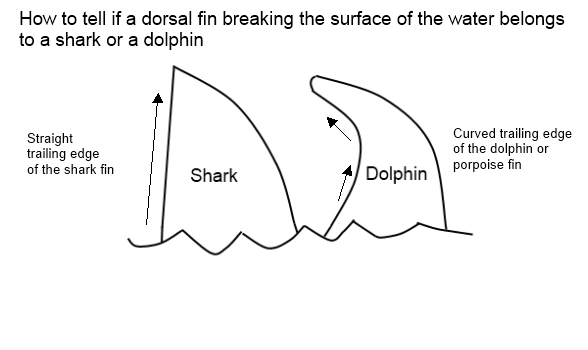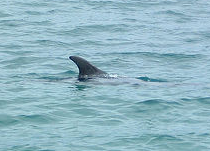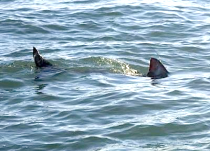I found this below regarding a different incident...
This Is Not A Shark

The Beast is a fisherman and a shark enthusiast, so when something sharky happens it goes on his blog. There really hasn’t been all that much going on lately (sharkwise) but The Beast has noticed in his various web searches certain pictures showing up over and over. One of the more popular is this shot of a large scary sea creature zipping by a surfer in the curl of a wave. People assume it’s a shark but is it?
Note the shape of the dorsal fin (A.), it’s curved, like the letter “C”. And the tail fin (B.), though faint, is broadly triangular and appears to be attached horizontally, not vertically, which would make it a fluke, not a fin.

Let’s compare dorsal fins.
Here’s a shark dorsal: 
Here’s a dolphin dorsal: 
Differences Between Dolphin Fins & Shark Fins By G.D. Palmer, eHow Contributor
Despite the fact that sharks are cold-blooded relatives of fish and dolphins are warm-blooded mammals, the two animals share a number of characteristics. They have sleek bodies, are a similar color, and have prominent triangular dorsal fins. It can be hard to tell a shark from a dolphin, especially from a distance. Fortunately, there are a few basic rules that swimmers can follow to determine whether or not they need to get out of the water. Once the observer knows what to look for, telling a shark fin from a dolphin fin becomes a lot simpler.
Number
According to Coastal Courier, most species of dolphins have just one dorsal fin, situated toward the middle of the back. Many shark species have a second dorsal fin, located closer to their tails. These fins may not protrude from the water unless the animal is swimming very close to the surface of the water. The secondary dorsal fin is usually much smaller than the primary one, but tends to mirror the shape of the larger fin.
Curve
A dolphin’s fin has a curved silhouette, while most shark fins have a straight forward edge. In some shark species, the rear edge of the dorsal fin may be curved. Some types of shark can also change the attitude of their dorsal fin, so that it droops slightly. However, a change in fin attitude is rarely severe enough to make it strongly resemble a dolphin’s fin. Shark fins may slant backward or stand up straight, but generally do not curve back in the same way as a dolphin’s dorsal fin. According to The Western Isles, porpoises, a relative of the dolphin, do have straight fins which may be mistaken for shark fins. These creatures are usually quite shy, however, and tend to stay away from humans.
Texture
The fins of most dolphins are smooth and firm, though some dolphins may show evidence of scarring from encounters with sharks, motorboats or other water hazards. Injured dolphins may have truncated or split fins. According to New England Sharks, many sharks have a notched or ragged look to the trailing edge of their dorsal fin. This is because shark fins are supported by many fibrous strands, unlike dolphin fins, which tend to be smooth. The degree of raggedness in shark fins varies by species and by individual. In some cases, it’s pronounced enough to be seen at a distance, while in others, it’s hard to see unless the viewer is very close to the shark.
Attachment
The rear edge of a dolphin fin is smoothly connected to the back of the animal, creating a gentle curve. In many shark species, the rear edge of the dorsal fin is actually slightly detached, creating a free tip. This detached area may not be readily visible unless the shark is swimming quite high in the water, or can be viewed from above.
http://www.ehow.com/print/list_6796616_differences-dolphin-fins-shark-fins.html





